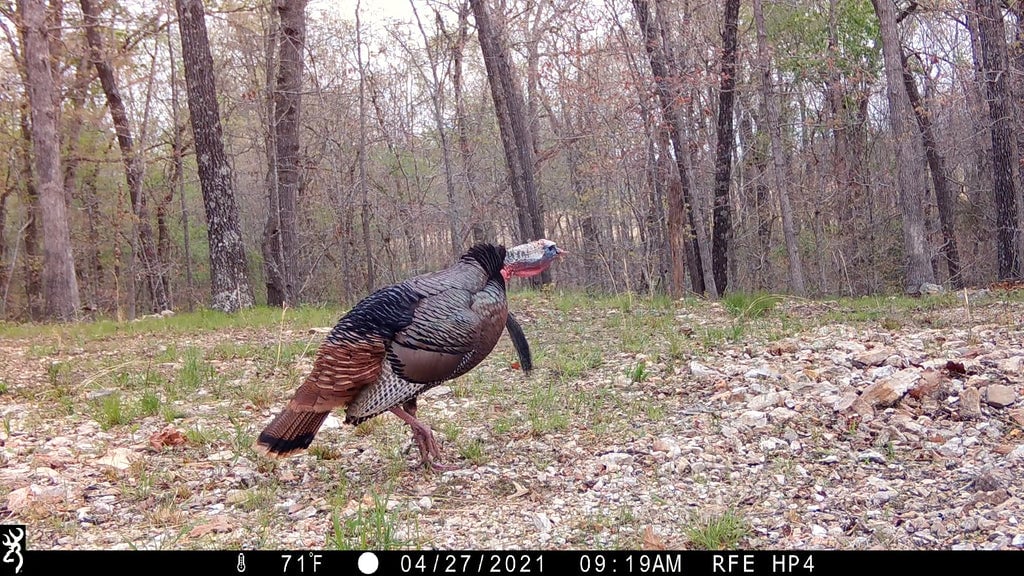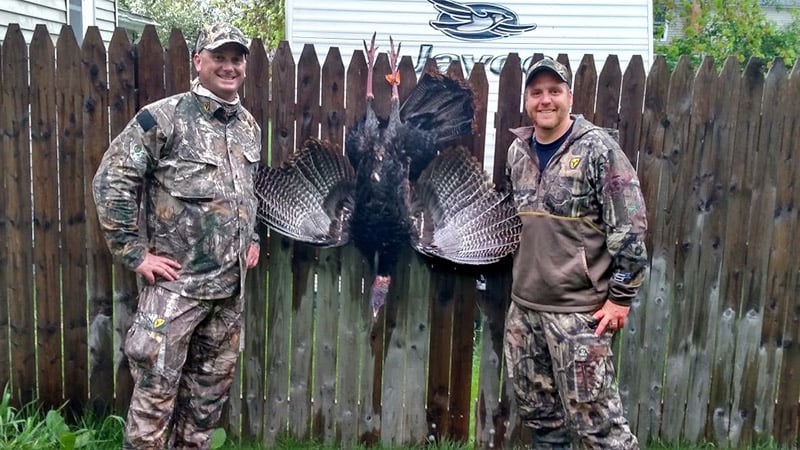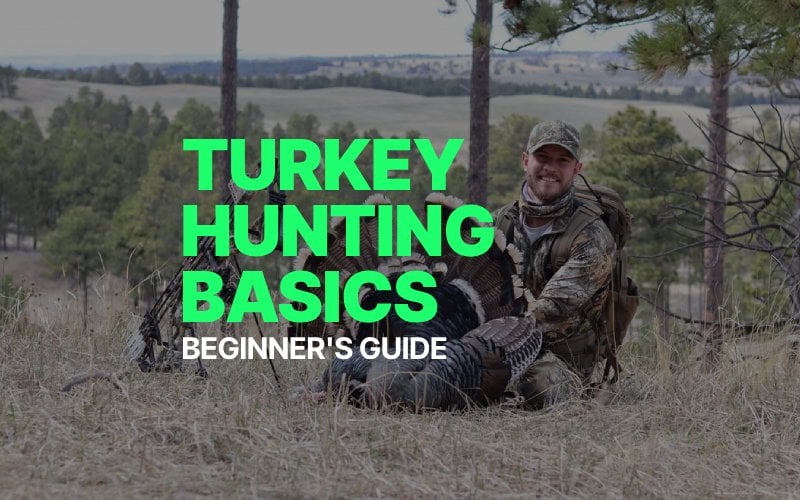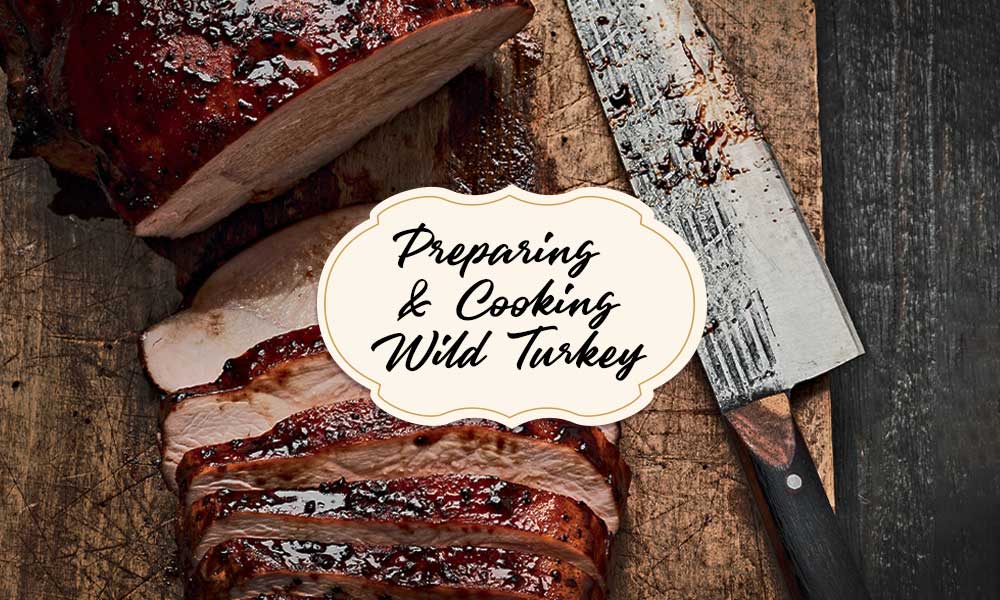Spring turkey hunting is an exciting challenge that many people want to try—but it can feel overwhelming at first. What gear do you need? How much does it cost? How to call turkeys? How to shoot turkeys? This guide will cover the basics of what you need to get started in turkey hunting, from essential gear to simple techniques.
When is spring turkey hunting season?
Spring turkey hunting season varies from state to state, typically starting in April. However, some start earlier, for instance, Mississippi and Texas (South Zone) begin as early as March 15, while Hawaii opens its season on March 1. For most of us, though, spring turkey season runs through April and wraps up by the end of May. There are a few exceptions—like Maine—where you can keep hunting into early June. For specific dates, hunters should always consult their state’s wildlife agency or hunting regulations.

Scouting: How to Find Your Spring Gobbler
To consistently find success, you need to understand the wild turkey’s habits and behavior, as well as the anatomy of the land you’re hunting. Here’s what to keep in mind.
Know the Habitat
Turkeys don’t just wander around randomly. They like to roost in tall trees, often near water. They prefer mature forests with plenty of cover, especially if there’s open fields or pastureland nearby. These areas give them everything they need—safe roosting areas, food, and protection from predators.
Before the season starts, take some time to walk through your hunting areas. Look for signs like tracks, dirt scratchings (where they’ve been feeding), feathers, or droppings. Pay close attention to the edges of fields and wooded areas too—turkeys love to strut out in the sunshine.
If you’re scouting unfamiliar ground, apps like OnX Maps or Google Earth are great tools to help you identify potential roosts or feeding zones based on terrain and vegetation.
Scout Early and Listen
Your best scouts are your ears. Generally, gobblers are very vocal in the early morning and at sunset as they try to attract hens. So get out early—like pre-dawn—and listen for gobblers sounding off as they wake up. Mark these spots on your mapping app or even a paper map. If a spot seems quiet, move on. Birds won’t always be vocal, but where you see tracks, scratchings, or feathers, turkeys aren’t too far away.
Pro Tip: Locator calls, like an owl hooter or crow call, are excellent tools to get toms to give away their location. Blow the call and wait to hear if a tom responds. Once you’ve pinpointed where they’re roosting, mark the location and plan to set up nearby for the hunt.
Understand Turkey Routines
Turkeys have pretty predictable routines, and knowing these can make all the difference when it comes to being in the right spot at the right time. Toms typically fly down from the roost at sunrise with hens, then follow them as they feed. Around mid-morning, hens often leave to lay eggs, leaving the toms to wander in search of new mates. This is your opening!
Knowing where the hens want to feed — fields, buggy areas, acorns, berries, or whatever food sources are abundant in your region — is vital. Setting up in or near these feeding zones is often a great strategy for intercepting turkeys.
You can use trail cameras to learn more about turkey behavior and patterns. Read: Trail Cams for Spring Turkeys
Turkey Hunting Gear
Having the right gear can make all the difference, but you don’t need to go overboard on the fancy stuff when you’re getting started. Here’s what to prioritize.
Shotgun and Ammunition
If you’re a beginner turkey hunter, we suggest starting with a shotgun, shifting to the bow only when experienced enough.
Fancy extras don’t matter much as long as your aim is solid, your choke is right, and the shells match your gun.
- Gauge: A 12-gauge was once the king for turkey, but these days, a 20-gauge or even .410 (if legal in your area) paired with heavy-hitting tungsten shells will do the job.
- Choke: Most hunters stick with a full or extra-full turkey choke for tight patterns up to 40 yards. It’s about precision, not power. Fancy turkey chokes are an option for experienced hunters but don’t stress over it for your first hunt.
- Ammo: Spend a little extra on premium tungsten shells for added knock-down power, especially if you’re just starting out. Tungsten in shot sizes #7-9 (like Federal TSS). If budget’s your focus, don’t discount classic lead or steel shells (#4-6), like Winchester Long Beard XR.
- Pattern your gun before you take it to the woods. Shoot at large paper targets (mark a 3” circle) at 20, 30, and 40 yards. You should see a dense pellet spread in that circle. If not, try different shells or adjust your aim.
Camo and Concealment
Turkeys have great vision. Forget your deer hunts — turkeys spot movement better than nearly any other animal in the woods. A full turkey camo outfit, including thin gloves, a high-quality spandex face mask, and a hat, is essential to break up your outline and keep you hidden.
When in doubt, match your turkey camo to your surroundings. Mossy Oak and RealTree patterns are an affordable starting point and work well in most environments. If you’re hunting public land, be cautious about using gobble calls or heavily realistic decoys, as they might attract more hunters than birds.
Cheap gear works just fine, so don’t feel pressured to overspend as a beginner. Just focus on blending in with your surroundings.

KINGS CAMO XKG Ridge Pants
$139.99
Price accurate at time of writing
Specs:
- Four-Way Stretch Polyester
- DWR Water Resistant Treatment
- Blood Resistant Finish
- Articulated Knee
- Grip Strip Inner Waistband
- Diamond Crotch
- Reinforced Bottom Hand Pocket (For Knife Clip)
- Streamlined Snap Close Cargo Pockets
- Extra Thigh Zipper Pocket
- Flap Over Back Pockets
- Snap Loop (Roll Up Pant Leg)
Decoys
Dacoys aren’t necessary but can work to your advantage. A simple setup of a hen and jake decoys about 20-30 yards from your shooting position works wonders. Early in the season, this combo attracts territorial toms looking to prove their dominance.
- When Not to Use Them: Later in the season, pressured birds may hang up outside of range, so use decoys sparingly.
Pro Tip: Always brush decoys in with surrounding vegetation when hunting public land for added realism and safety.
Also, read this expert’s guide to Using Turkey Decoys for Success

PRIMOS Killer B Turkey Decoy
$84.49
Price accurate at time of writing
Specs:
- Strutting Gobbler Decoy
- B-Mobile Silk Fan
- 90' Pull Line
- Mobile Series Fan Holder
- Mobile Series Ground Breaker Decoy Stake
- Carrying Bag
Optional Gear
- Hunting Seat or Pad: Sitting still for long periods is the hardest part of turkey hunting. A good seat or butt pad can make it a lot easier. Choose something lightweight and comfortable, like a low-profile, foldable turkey chair. If you’re on a budget, use a basic foam pad. Your back (and butt) will thank you!
- Vest or Pack for Your Gear: Vests are popular among turkey hunters because they keep your calls, shells, and the rest of your gear organized. A fanny pack or compact backpack works fine too.
- Binoculars: Spotting turkeys in the distance is much easier with a small pair of binoculars. Opt for moderate magnification – 8x or 10x for versatility.
- Water and Snacks: Spring hunts can take you deep into the woods and keep you there for hours. Stay hydrated and bring a protein bar or two.
- Blinds: Great for beginners, but they’re optional. Brush them in with local foliage to blend in.

HILLSOUND BTR Stool
$89.95
Price accurate at time of writing
Specs:
- PhantomLock
- Ultralight
- Small and packable
- Quick setup [less than 10 seconds]
- Detachable seat
- Bungee cord fastening for tidy storage
Turkey Calls & Calling Techniques
During the spring season, gobblers are looking for hens to breed with, while hens are going about their daily routines. Your role is to mimic the sounds of a hen to lure the gobbler toward your setup. Calling significantly increases your chances of a successful hunt because turkeys are incredibly sharp-eyed and wary animals and can quickly disappear at the slightest misstep. That’s why understanding turkey calls is essential to getting them up close.
Which Turkey Calls to Use
Start with simple-to-use calls, like a slate or glass pot call, or a box call. They’re easy to master and effective in mimicking basic turkey sounds like yelps and clucks. Top brands like Primos Hunting offer excellent tutorials on YouTube to learn the basics.
If you’re familiar with diaphragm calls (mouth calls), you can add a couple to your toolkit. They allow you to call hands-free but they require practice and are typically not recommended for beginners.

PRIMOS Power Crystal Turkey Call
$27.58
Price accurate at time of writing
Specs:
- Crystal surface is super-hard, creating calls that peak at 15,000 Hz
- Includes hardwood striker
- Includes conditioning pad and super abrasive sandpaper
How to Call a Turkey
What Time Should You Start?
Turkeys typically fly down from their roosts just after sunrise. Be in position before dawn, about 75-100 yards from their roost. Start with soft yelps or purrs about 10 minutes before sunrise to gauge their location and mood. Avoid loud, aggressive calling during this time.
How Often Should You Call?
Many beginners make the mistake of overcalling. A good rule of thumb is to call every 20 minutes if you’re not hearing gobbles. If a tom responds, reduce your calling frequency.
If you’re unsure, err on the side of silence. Turkeys are naturally curious and will often investigate on their own.
What Calls to Use
For starters, you need to master only two calls:
- Yelp: Your go-to call for attracting attention. It’s versatile and can be done at varying volumes.
- Cluck: A feeding chatter turkeys use to communicate casually. Great for close-range communication.
The other are more special:
- Purring: The sound of a relaxed turkey, perfect for calming nearby birds.
- Cutting: Aggressive and sharp sounds to excite a tom. Use this sparingly to avoid spooking them.
Also note that turkeys have an “accent.” Yelp too slow, and you’ll sound unconvincing; too fast, and you’ll sound desperate. Aim for a rhythm that mimics natural turkey sounds.
Hunting Turkeys on Public Land
Hunting on public land can feel like competing against the gobbler AND other hunters. Here’s how to tip the scales in your favor:
- Scout Early and get there before sunrise to claim good ground.
- Stay Silent unless absolutely necessary. Public land birds are more cautious and often associate loud, aggressive calls with danger.
- Be Safe and mindful of your surroundings—other hunters might mistake you or your decoys for a real bird, so wear some orange while walking in/out.

How to Hunt Turkey: Tips for Success
Don’t rely too heavily on your gear
It’s easy to get sucked into thinking you need the latest camo patterns, high-end shotguns, or premium box calls to succeed. While good equipment is helpful, having top-of-the-line gear doesn’t make you a turkey hunting expert—not by a long shot.
Instead, focus on the basics. A reliable shotgun, decent turkey hunting camouflage, and a functional call are enough to get the job done. The real key lies in mastering turkey behavior and honing your calling and setup skills. Fancy gear won’t help if you aren’t prepared mentally and practically.
Set up smartly
Place decoys in clear view, ideally with the sun behind you to avoid being backlit. Sit with your back to a tree and wide-open shooting lanes in front of you.
Be flexible and adapt
Many turkey hunters fall into the trap of doing everything “by the book”—setting up just so, expecting turkeys to come in a specific way, and refusing to adjust when things don’t go as planned. But turkeys don’t read your rulebook, and getting stuck in one style of hunting can leave you frustrated.
Turkey hunting is about adaptability. If a gobbler isn’t responding to your calls on the edge of the field, try moving into the timber. If calling isn’t working, stay quiet and use decoys strategically. Be willing to experiment—you’ll learn more and improve faster.
Be patient
Hunting turkeys can be quite frustrating. They’ll hang up, go quiet, or move unpredictably. Learn to sit still longer than you think is necessary and don’t relocate too soon. A tom might sneak in right after you leave.
When you feel like you’ve waited long enough, wait another 30 minutes.
Move slowly
Turkeys rely on their sharp eyesight to survive. One sudden movement or a poorly concealed setup can instantly ruin your shot. Many beginners underestimate just how cautious these birds are.
Move slowly and deliberately, staying as still as possible while calling or waiting. Use natural cover such as trees or brush, and break up your outline with camo. If you’re in a blind, make sure your movements are hidden from a gobbler’s view.
Follow up if they hang up
If the gobbler stops midway to your setup, he might be stuck in a pattern or waiting to see more movement. When this happens, reflect his interest with more aggressive calling, but be silent if he stops responding.
If he moves off entirely, you can try sneaking closer to his last known position — but stay low and use trees as cover to avoid being spotted.
Don’t stop mid-day
A lot of hunters pack it in after the morning activity dies down, but staying out can pay big dividends. By mid-day, gobblers may leave their hens and be ready for another “date.” Moving lightly and calling softly can help locate these lonely toms.
Make notes for next time
Turkey hunting can be tough. You’ll encounter days when nothing goes your way, gobblers won’t respond, or you miss your shot entirely. Beginners often get discouraged when this happens, leading to frustration and burned-out enthusiasm.
Stay mentally tough. Every unsuccessful hunt is an opportunity to learn. Reflect on what went wrong and what you can adjust.
FAQs: trails cameras, decoys, patterns
There are two main places to consider:
- Strut Zones: Open areas where turkeys can display and be seen, usually in spots with a lot of sunlight to highlight their iridescent feathers.
- Transition Areas: These are paths between roosting spots, strut zones, and feeding areas. They are often more convenient to access and can provide valuable information about turkey movements.
When checking trail cameras, timing is crucial to avoid spooking the turkeys:
- Avoid checking strut zones in the morning when turkeys are active.
- Don’t check near roosting areas right before dark to prevent scaring them away.
- Use a vehicle like a truck or UTV to appear less threatening, and make noise or talk out loud while approaching to ensure turkeys don’t associate the noise with a hunter.
You can still gather valuable information without covering all areas. Use a rake to clear a patch of ground and check for fresh tracks, beard marks, or droppings over the next few days.
- Tracks: Observe the direction of movement.
- Droppings: Hen droppings resemble popcorn, while tom droppings are shaped like a “J.”
- Beard and wing marks: Look for signs of a strutting tom dragging its beard or wingtips behind.
- Droppings: Hen droppings are small and look like popcorn. Tom droppings are larger and shaped like the letter “J.”
- Tracks: A tom’s side toe sits more perpendicular to its middle toe. A hen’s side toe is angled more forward.
Turkeys respond differently to various decoys, depending on the time of the hunting season or the bird’s temperament. Common decoy options include:
- Hen decoys (feeding, alert, loafing, or breeding) to attract toms seeking mates.
- Jake or tom decoys (half-strut or full-strut) to invite aggression from dominant birds.
- Specialty decoys such as wounded toms, which can trigger aggression in other males.
High-quality, realistic decoys with accurate colors, size, and added features like real feathers or tails are more effective than economy foam options.
Early spring turkey: Use a mix of jake/tom decoys with hens to attract dominant or confident birds establishing their pecking order. Some birds may be intimidated by strutting decoys early on, so adjust if needed.
Mid-season: Toms are at their most aggressive and hormone-driven. Combine several hens with dominant jake or tom decoys for maximum effectiveness.
Late spring turkey: Stick with lone hens or a relaxed pair of hens, as many toms are no longer aggressive and may respond better to subtle setups.
Keep decoys 15-35 yards away from your setup. This range allows for an ethical shot even if the tom hesitates before closing in.
Avoid placing decoys in the tom’s direct line of sight with you behind them, as turkeys will spot even small movements. Instead, position decoys at an angle where the bird must cross in front of you to approach.
Spread out decoys naturally as turkeys would behave in the wild, avoiding tight clusters that suggest alertness or insecurity.
Place decoys where the tom can focus on them and not your position, ensuring you remain concealed.
For birds with highly predictable habits, decoys might disrupt their natural behavior. It’s often best to hunt without decoys in these situations.
Birds subjected to heavy hunting pressure or decoy encounters may recognize setups and avoid them. Adjust tactics such as setup locations, decoy types, or calling intensity to outsmart these wary birds.
Ensure you have the following:
- Supplies: Bring enough food and water to keep your energy up for an entire day.
- Clothing: Wear layers like ScentBlocker Merino wool base layers for comfort and warmth, along with durable outerwear for protection.
- Hunting Gear: Carry essential items like your calls, decoys, a reliable shotgun, and a good hunting vest to stay organized.
- Check Regulations: Confirm local hunting laws regarding hunting hours and permits to ensure compliance.
Turkeys follow distinct routines based on the time of day, and hunting in phases ensures you’re in the right spots at the right time:
- Phase 1 (First Light): Target roosting areas before turkeys fly down. Soft calls and decoys can help attract attention.
- Phase 2 (Mid-Morning): Head to strutting zones like field edges, ridge tops, or flat river bottoms where toms display after hens return to their nests.
- Phase 3 (Midday to Afternoon): Visit dust bowls, where turkeys gather and clean themselves. If this doesn’t work, use a “running and gunning” approach—move slowly and call to locate toms.
- Phase 4 (Late Afternoon to Evening): Return to roosting areas as turkeys come back to roost for the night.
Closing Thoughts
Turkey hunting requires persistence. Too many beginners hang up after a few failed attempts, especially if turkeys “aren’t doing right” and not coming in the way they expect.
Keep a positive and determined mindset. Adapt your approach and try again. And don’t expect every hunt to end with a bird in the bag.
Remember, turkeys are always “doing right”—it’s up to you to figure out how to work with what they’re naturally doing.
Also, read:
The Perfect Turkey Hunting Plan
When Turkey Hunting: Stick To The Plan











